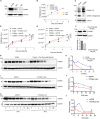This is a preprint.
Integrated in vivo functional screens and multi-omics analyses identify α-2,3-sialylation as essential for melanoma maintenance
- PMID: 38559078
- PMCID: PMC10979837
- DOI: 10.1101/2024.03.08.584072
Integrated in vivo functional screens and multi-omics analyses identify α-2,3-sialylation as essential for melanoma maintenance
Update in
-
Integrated in vivo functional screens and multiomics analyses identify α-2,3-sialylation as essential for melanoma maintenance.Sci Adv. 2025 Jul 4;11(27):eadg3481. doi: 10.1126/sciadv.adg3481. Epub 2025 Jul 4. Sci Adv. 2025. PMID: 40614178 Free PMC article.
Abstract
Glycosylation is a hallmark of cancer biology, and altered glycosylation influences multiple facets of melanoma growth and progression. To identify glycosyltransferases, glycans, and glycoproteins essential for melanoma maintenance, we conducted an in vivo growth screen with a pooled shRNA library of glycosyltransferases, lectin microarray profiling of benign nevi and melanoma patient samples, and mass spectrometry-based glycoproteomics. We found that α-2,3 sialyltransferases ST3GAL1 and ST3GAL2 and corresponding α-2,3-linked sialosides are upregulated in melanoma compared to nevi and are essential for melanoma growth in vivo and in vitro. Glycoproteomics revealed that glycoprotein targets of ST3GAL1 and ST3GAL2 are enriched in transmembrane proteins involved in growth signaling, including the amino acid transporter Solute Carrier Family 3 Member 2 (SLC3A2/CD98hc). CD98hc suppression mimicked the effect of ST3GAL1 and ST3GAL2 silencing, inhibiting melanoma cell proliferation. We found that both CD98hc protein stability and its pro-survival effect in melanoma are dependent upon α-2,3 sialylation mediated by ST3GAL1 and ST3GAL2. In summary, our studies reveal that α-2,3-sialosides functionally contribute to melanoma maintenance, supporting ST3GAL1 and ST3GAL2 as novel therapeutic targets in these tumors.
Keywords: Melanoma; ST3GAL1; ST3GAL2; cell growth; glycosyltransferase; α-2,3 sialylation.
Figures






References
Publication types
Grants and funding
LinkOut - more resources
Full Text Sources
Research Materials
